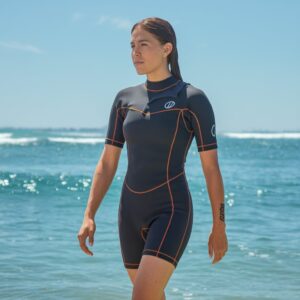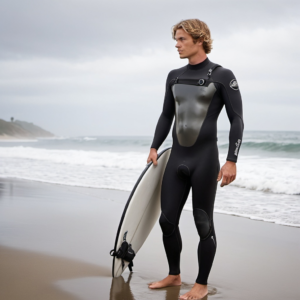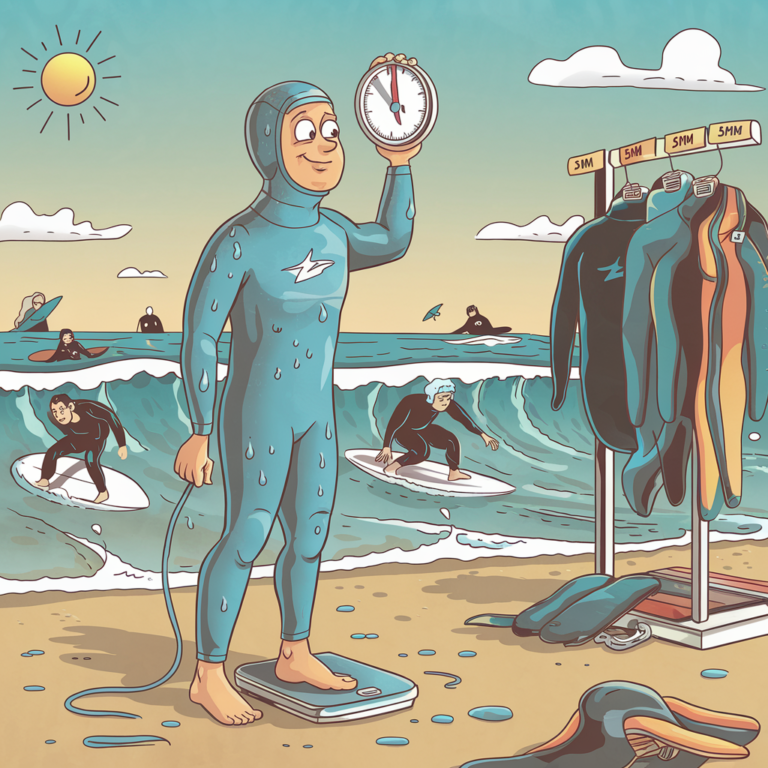Wetsuits are worn by surfers all over the world.
Where I live on the west coast of Canada, wetsuits, booties and gloves are necessary in the winter because ocean water temperatures are cold and range from 7°C to 9ºC (45°F to 48ºF).
When you go surfing in a wetsuit, you will be carrying around extra weight that may impact your explosiveness, mobility and flexibility.
In the past, I never really thought about how much extra weight I was carrying around when I was all suited up to go surfing. I spent some time researching the question and weighing all my wetsuit gear (and some of my friends gear too!) to determine the weight of different wetsuits.
Although it depends on the size, style and thickness, wetsuits can add 2-10 pounds (lbs) of weight to a surfers body. A shorty wetsuit is light, while a full suit with accessories like booties and gloves will add more weight than you might think.
Wetsuit Weights
I weighed a number of different wetsuits and recorded the information in the table below.
| Wetsuit Brand & Style | Size | Thickness | Dry Weight | Wet Weight |
| O’Neill Hammer Shorty (Men’s) | M | 2mm | 1lb 1oz | 2lbs 11oz |
| O’Neill Long John (Men’s) | L | 2mm | 1lb 9oz | 2lbs 15oz |
| Rip Curl Dawn Patrol Full Suit (Men’s) | MT | 3mm/2mm | 2lbs 11oz | 3 lbs 15 oz |
| Excel Full Suit (Women’s) | 8T | 4mm/3mm | 3lbs 2oz | 4lbs 12oz |
| O’Neill Heat (Men’s) | M | 5mm/3mm | 3lbs 9oz | 5lbs 10oz |
| Rip Curl Flash Bomb Hooded Full Suit (Men’s) | L | 5.5mm/4.5mm | 4lbs 10oz | 7lbs 12oz |
| O’Neill Hyper Tech Hooded Full Suit (Men’s) | L | 5.5mm/4.5mm | 3lbs 15oz | 6lbs 2oz |
| Patagonia R4 | L | 5.5mm/4mm | 4lbs 5oz | 6lbs 2oz |
| Need Essentials | MT | 6mm/5mm/4mm | 4lbs 5oz | 6lbs 14oz |
You can find more info about wetsuit in this article:
Wetsuit Buying Guide for Beginner Surfers
Booties & Glove Weights
I weighed a number of different accessories and recorded the information in the table below.
| Brand & Style | Size | Thickness | Dry Weight | Wet Weight |
| Booties | ||||
| Excel Reef Booties (Men’s) | 12 | 2 mm | 11oz | 1lb |
| Rip Curl Flash Bomb Booties (Women’s) | 9 | 5 mm | 13oz | 1lb 2oz |
| Excel Infinit Booties (Men’s) | 12 | 5 mm | 1lb 1oz | 1lb 6oz |
| Patagonia R4 Booties (Men’s) | 12 | 5 mm | 1lb 3oz | 1lb 9oz |
| Excel Booties (Men’s) | 12 | 7 mm | 1lb 6oz | 1lb 11oz |
| Gloves | ||||
| Rip Curl Flashbomb | M | 3mm/2mm | 5oz | 9oz |
Read this for more info about surf booties and gloves:
Surfing Gloves FAQ: 8 Useful Things You Need to Know
Surfing Booties FAQ: 9 Useful Tips You Need to Know
The Process: Weighing Wetsuits
I will quickly explain the process I followed in order to weigh the wetsuits & accessories and maintain a consistent level of accuracy.
First of all, I started with completely dry wetsuits & accessories and weighed them separately on a food scale.
I used the same waste bucket as the container and I recorded the tare, which is the weight of the empty container, so I could subtract the weight of the container from the total weight of each item.
Then, I submerged the wetsuits & accessories in my daughter’s kiddie pool until they were completely soaked.
I recognize that fresh water from the garden hose is slightly lighter than salty ocean water but it is a very small percentage so I didn’t make any adjustments to the wet weights in the table below.
If you want to adjust for the extra weight of salt water, just add 1-2 ounces to the weight of each wetsuit.
After that, they were transferred to the deck railing for a short drip dry to get rid of excess water.
The process got a bit subjective because I used my own experience to know when it was time to weigh the wet wetsuits. Wetsuits only trap a thin layer of water against your skin so when you come out out of the water, your wetsuit will be waterlogged but it shouldn’t have huge pockets of trapped water.
Each wetsuit and accessory was returned to the container and weighed individually a second time to record the wet weight.
The same process was repeated for each wetsuit & accessory.
Does Wetsuit Weight Matter?
If your wetsuit is less than 3mm thick and weighs less than 4 pounds (lbs), you won’t necessarily notice the added weight when surfing.
Also, the added buoyancy of salt water combined with a small amount of flotation provided by your wetsuit will make you feel less heavy in the water.
Surfers spend the majority of the time in the ocean paddling around, waiting for waves and sitting or lying prone on their surfboards. So you won’t really notice the added weight of a wetsuit until you are standing up.
That being said, in colder environments where a hooded full suit, booties and gloves are necessary, wetsuits and accessories can add up to 10 pounds (lbs) of extra weight.
The added weight is significant and will impact your explosiveness and flexibility. You will feel a step slower and you may need to make adjustments like riding a bigger surfboard.
For tips on how to maximize your wave catching ability in cold climates, check out my article on 15 Essential Tips for Cold Water Surfing
What Affects the Weight of a Wetsuit
Size
The size of a wetsuit will impact the overall weight. All other things being equal like style and thickness, it seems obvious but a large wetsuit will weigh more than a small wetsuit because there is more material in the wetsuit.
Style
The style of wetsuit will impact the weight because the amount of material coverage is different. A Shorty wetsuit, which has short arms and short legs is made for warm water, while a Hooded Full Suit, which has long arms & legs and an attached hood is made for cold water.
See the photos below for a comparison between the different styles discussed in this article.
Shorty

Long Jane/John
Full Suit

Hooded Full Suit

Thickness
Wetsuits keep you warm by trapping a thin layer of water against your skin that is heated up by your body temperature. Generally, the thicker the wetsuit, the warmer it will be.
Wetsuit thickness is expressed in millimetres (mm). When you are shopping for a wetsuit, you will notice that the thickness may have one, two or three numbers. The first digit is the thickness in the torso and the remaining digits are the thickness in the arms and legs. I have provided an explanation below.
- 2mm – the wetsuit is 2mm thick
- 4mm/3mm – the wetsuit is 4mm thick in the torso and 3mm thick in the arms and legs
- 6mm/5mm/4mm – the wetsuit is 6mm thick in the torso, 5mm in the legs and 4mm in the arms.
A thicker wetsuit will provide more warmth but it will also add more weight.
Material & Construction
Although most wetsuits are made out of neoprene, the wetsuit material including liners, will vary between different manufacturers.
Because wetsuits are made to get wet and trap a thin layer of water against your skin. They will be heaver when they are wet. Some manufacturers use internal liners that absorb less water and dry quicker, which makes them lighter.
Newer wetsuits will typically take in less water because the seams are completely sealed. As your wetsuit ages, gets small cuts and tears and starts to stretch out, your wetsuit will let in more water.
Lots of water inside your wetsuit is a bad thing because it will make you colder and become very heavy.
In Conclusion:
Wetsuits are one of the most important pieces of surfing equipment and surfers wouldn’t be able to chase waves in most climates without them.
Although wetsuits make you heavier, it shouldn’t affect your performance. By choosing a well fitting, surfing specific wetsuit, you will be comfortable and warm in the ocean.
When you are standing up, riding waves and feeling the wind whipping past your face, the pleasure you feel will outweigh any small amount of additional wetsuit weight!





